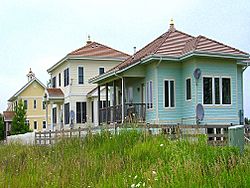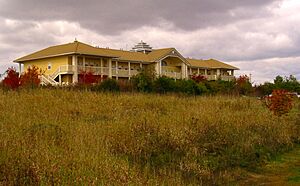Maharishi Vedic City, Iowa facts for kids
Quick facts for kids
Maharishi Vedic City, Iowa
|
|
|---|---|

Homes in Maharishi Vedic City
|
|
| Country | |
| State | |
| County | Jefferson |
| Area | |
| • Total | 3.34 sq mi (8.65 km2) |
| • Land | 3.34 sq mi (8.65 km2) |
| • Water | 0.00 sq mi (0.00 km2) |
| Elevation | 791 ft (241 m) |
| Population
(2020)
|
|
| • Total | 277 |
| • Density | 82.91/sq mi (32.02/km2) |
| Time zone | UTC-6 (Central (CST)) |
| • Summer (DST) | UTC-5 (CDT) |
| ZIP codes |
52556
|
| Area code(s) | 641 |
| FIPS code | 19-48500 |
| GNIS feature ID | 2395815 |
| Website | www.maharishivediccity-iowa.gov |
Maharishi Vedic City (MVC) is a special city in Jefferson County, Iowa, United States. It's known for its unique design and focus on an organic lifestyle. The city was officially started in 2001. It was the first new city to be created in Iowa since 1982.
Maharishi Vedic City is quite small, covering about one square mile. It's located about four miles north of Fairfield, which is home to Maharishi University of Management. The city's buildings and overall plan are based on something called Maharishi Sthapatya Veda. This is an ancient system of architecture and design that was brought back by Maharishi Mahesh Yogi. The main goal of this design is to help people feel "protected, nourished, and satisfied."
Contents
History of Maharishi Vedic City
How the City Was Founded
The idea for a "Vedic City" came from Maharishi Mahesh Yogi. In 1991, a real estate developer and others started working to make this vision a reality. They wanted to create a town based on ancient Vedic principles. The city council's first rule even said that the city's plan was based on "Total Natural Law."
Developers bought many farms, about 3,000 acres in total. About 1,200 acres were set aside for the town itself. They planned a city with ten circles, covering about one square mile. They also built roads, utilities, and internet connections. The first part of construction included two hotels, houses, and office buildings. After one year, 46 buildings were finished, and over $35 million had been spent.
Becoming an Official City
Because of the need for money and services, the developers asked the state to make it an official city. After a special vote, it became Iowa's newest city on July 25, 2001. This was the first time a new city was formed in Iowa since 1982. The planners hoped the city would have over 1,000 people by 2010. Many of these new residents were expected to move from nearby Fairfield.
Protecting Nature and Growth
When the city was first being developed, Maharishi Vedic City set aside 50 acres of land for nature. These areas, which used to be farms, were turned into native prairies, wetlands, and forests. In 2002, a building called "The Mansion" became the main office for the Global Country of World Peace. The current Mayor of Maharishi Vedic City is Rogers Badgett.
By 2006, the city had more than 200 buildings. In 2011, a TV show called "America's Most Unusual Town" was filmed there. It aired on the Oprah Winfrey Network in March 2012 and showed Oprah Winfrey's visit to Fairfield and Maharishi Vedic City.
Organic Economy and Green Living
Banning Non-Organic Food
Maharishi Vedic City is unique because it focuses on organic living. In November 2002, the city council passed a rule that banned the sale of non-organic food within the city. This means you can only buy organic food there.
Tours and Organic Farming
Since 2003, the city has offered tours to the public, and thousands of people visit each year. The city has its own organic farm. This farm grows fruits and vegetables that are sold to stores like Whole Foods Market and restaurants in nearby cities like Iowa City, Des Moines, and Chicago.
Maharishi Vedic City and Fairfield also get money from the government to develop renewable energy sources and recycling programs.
First All-Organic City
In April 2005, the city council voted to ban the use of man-made pesticides and fertilizers within the city limits. This made Maharishi Vedic City the first all-organic city in the United States.
Geography of Maharishi Vedic City
Maharishi Vedic City covers about 3.36 square miles (8.65 square kilometers) of land. There is no water area within the city limits.
Population and People
How Many People Live Here?
Maharishi Vedic City is a small community. According to the 2020 census, 277 people lived in the city. The population density was about 82.9 people per square mile.
Who Lives in Maharishi Vedic City?
In 2020, there were 159 households in the city. Most residents were White (84.5%), with smaller numbers of Black or African American (5.4%), Asian (5.1%), and other races. About 2.2% of the population was Hispanic or Latino.
The median age in the city was 67.9 years old. This means that half the people were younger than 67.9, and half were older. Most residents were 65 years or older (64.3%). There were slightly more females (52.7%) than males (47.3%).
Unique Features of the City
Maharishi Sthapatya Veda Architecture
Maharishi Vedic City uses a special building system called Maharishi Sthapatya Veda design architecture. This ancient Indian system is believed to bring happiness, peace, and good fortune to the people who live in these buildings. All structures are built with specific proportions. Rooms are placed based on how the sun moves, and main entrances always face directly east.
Each building also has a quiet, central area called a "brahmasthan." There's also a special border around the property called a "vastu fence" and a gold-colored decoration on the roof called a "kalash."
The Vedic Observatory
One of the city's unique attractions is an outdoor Vedic Observatory. It has ten large, white instruments made of concrete and marble, each about six feet tall. They are arranged in a circle. According to the observatory's creator, Tim Fitz-Randolph, these instruments are perfectly lined up with the sun, moon, and stars. They can be used to track the movements of these celestial bodies.
Organic Farm and Green Energy
The city also has a 160-acre organic farm with a large greenhouse. A wind turbine helps provide electricity for the greenhouses. This turbine was partly paid for by a government grant for renewable energy. The farm grows many different fruits and vegetables.
The city plans to expand its greenhouses even more. Maharishi Vedic City does not have streetlights or utility poles. Its long-term plan includes only electric cars within the city limits. The city council has also decided to provide its residents with "off-grid power" using wind and solar energy.
Hotels and Wellness Centers
There's a special wellness center and hotel called "The Raj" in Maharishi Vedic City. It's on a 100-acre property with gardens, lakes, and nature trails. It offers various treatments based on the Maharishi Vedic Approach to Health. The city also has the Rukmapura Park Hotel, which is a 25-room wooden hotel designed like European country inns.
Community Practice and Future Plans
The city's original plan from 2001 included two large domes in the center. These domes are meant for group practice of the Transcendental Meditation technique and the TM-Sidhi program, which includes Yogic Flying. Residents believe that when many people practice these techniques together, it can create a positive effect for the entire country.
See also
 In Spanish: Maharishi Vedic City (Iowa) para niños
In Spanish: Maharishi Vedic City (Iowa) para niños



